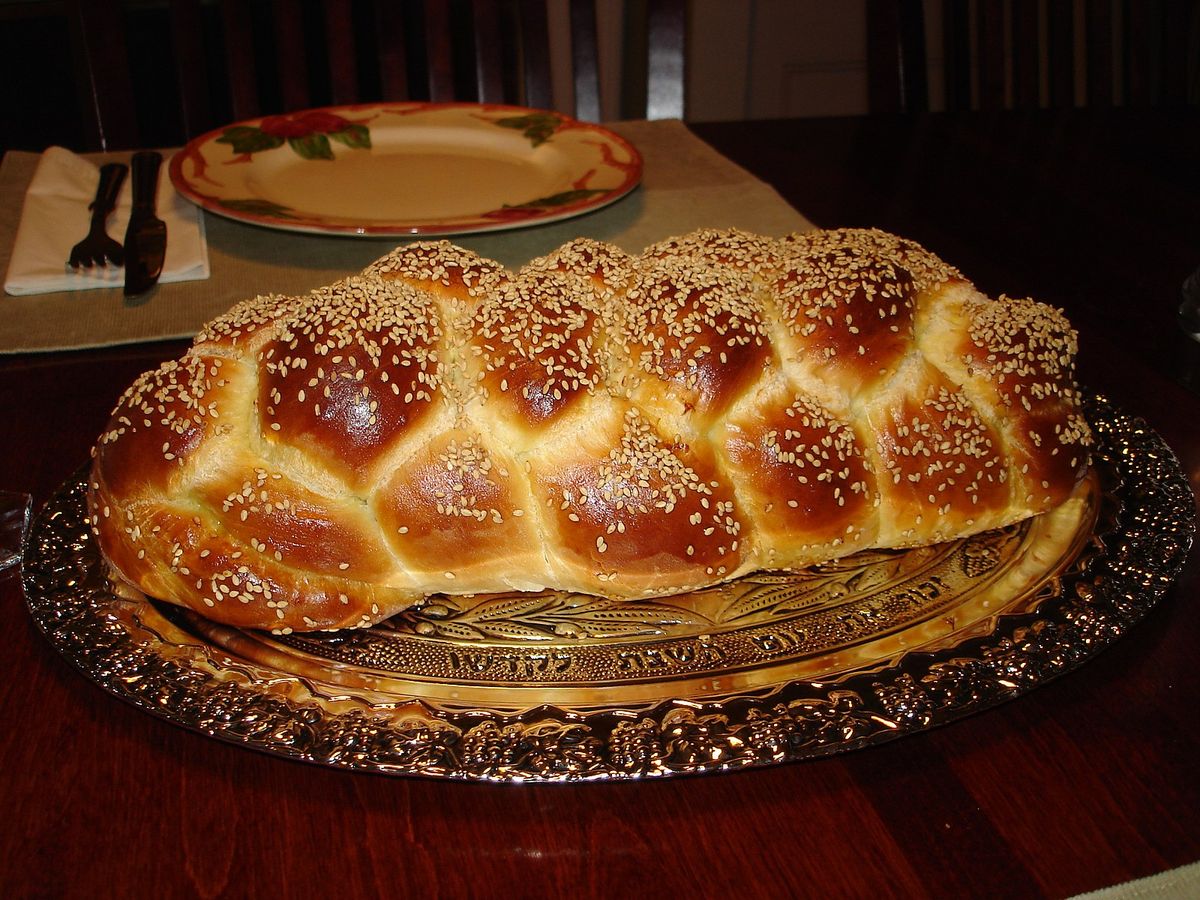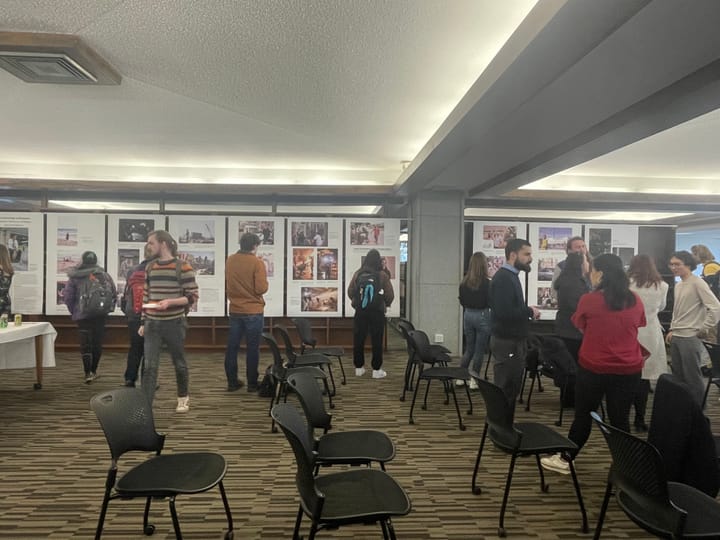Seeing Double: How to Make Challah
Seeing Double Columnist Cole Graber-Mitchell ’22 reflects on his Jewish identity, his connections to the Amherst community, and a very special loaf of bread.


One of my favorite holidays is Passover. For as long as I can remember, I’ve flown from Minneapolis to Connecticut every year to celebrate Passover with my dad’s family. We spend a day cooking great food and moving tables so we can entertain dozens of people in my grandparent’s small living room. During our Seder, some of my family members read along in Hebrew, while others — that is, my entire immediate family — join in afterward with our Haggadah’s English translations.
Those memories have shaped me and my conception of myself. I feel Jewish because every year I observe a tradition that my dad, and his mom, and her parents, and so on and on, have observed.
At the same time, my Jewish identity has always been a little unsteady. I didn’t grow up the way that most of the Jews I know grew up. I didn’t go to Hebrew school or synagogue; I didn’t have a bar mitzvah. My immediate family didn’t celebrate any Jewish holidays beyond Passover and sometimes Hanukkah, and neither did most of my extended family. Any time Judaism came up in middle and high school, someone would remark that Jewish law said inheritance of Judaism was matrilineal. I would be left wondering what that made me, a kid with a Jewish-Scottish dad and a German-Italian-French mom.
I thought that college would be the perfect place to learn more about Judaism and embrace my heritage. Maybe I could start going to a synagogue, or celebrate holidays with other Jews on campus. I hoped to find a Jewish community at Amherst where I could finally shed my uncertainty about who I was.
The summer before my freshman year, I browsed through Amherst’s religious life website and the websites of local Jewish organizations to see what I could take advantage of when I got here.
But I never followed through. Not because of some lack of resources at the college or in town; this article isn’t one of my many critiques of Amherst. I didn’t seek out Jewish community because I was scared. How could I fit in at a High Holidays service when I didn’t know the prayers? I was so certain that I would be the odd one out at any Jewish event: the only person in the room with none of the shared experiences that link Jews together regardless of their home states or backgrounds. I would be the goyish Jew — or even worse, they might not think I was Jewish at all because of my patrilineal descent.
I’ve worked up the courage to reach for Jewish community at Amherst a couple of times, but I’ve never succeeded. In my first months here, I attended a Rosh Hashanah service in Chapin, but I felt out of place enough that I couldn’t go back. In my junior year, I tried joining one of the Zoom services held by the Jewish Community of Amherst. I quickly realized that I was the only person there who wasn’t a member of that tight-knit community, and I left.
Part of my worries stemmed from my opinions on the Israeli occupation of Palestine. In high school, a Jewish teacher had become incensed when I indicated my disapproval of the Israeli government’s actions. Another student — not a Jew — said I was an antisemite. I knew that Jews hold a variety of opinions on Palestine because of opinion polling, my Jewish friends in high school, and common sense, but I was scared that I would be cast out of any Jewish community at Amherst because of my criticisms. (And in fact, ever since I spoke out in favor of Palestinian rights last spring and argued in support of the AAS’ email on Palestine, I’ve gotten dirty looks from a couple Jews on campus whom I’ve never even met.)
It wasn’t until this year that I found a Jewish community where I really felt comfortable. It’s an impromptu community, sprung up around semi-regular, highly informal Shabbat celebrations led by a Jewish friend of mine here. She usually invites a handful of people, but anyone who happens to pass by is encouraged to join. We light some candles, drink some wine, eat some challah, and sing some prayers.
I don’t know those prayers beyond their first phrases (which thankfully are the same as the Hanukkah prayers I know), and every time that we sing them I feel a twinge of anxiety when I drop out halfway through. It’s still hard for me to not run away from a situation that highlights a core tension in my sense of myself. But nonetheless I feel supported there, surrounded by friends who know how I’m Jewish and who, in many cases, had similar Jewish childhoods themselves.
A few weeks ago, I helped make the challah for one of these celebrations. I had never learned how to make challah as a kid, and this was my second time ever trying. (The first time was a disaster.) We mixed the flour, egg, yeast, and water with our hands before letting the dough rise and braiding it into two loaves. Later, we tore the challah apart with our hands, said “Shabbat shalom” to each other, and ate. I felt more connected to my Jewish heritage in those moments than I ever had before.
I expect my quest to understand my relationship with Judaism to be lifelong. Last year, my final project for a course on the Jewish and Asian American experiences (“Model Minorities,” with Professors Bergoffen and Odo) was an oral history of my Jewish family. After interviewing my grandmother, my dad, and my sister, I realized that we had all struggled with Jewish identity and that the struggle never ended.
I still want to learn more about being Jewish: more of the customs and stories, more of the ritual prayers, more of the recipes. A part of me still wants some sort of Jewish fairy godmother to provide me with an ad-hoc, postsecondary Hebrew school education. “This is the prayer said over challah,” such a person would say. “And the holiday coming up celebrates this particular time the Jews almost died. Do you know that story?” I’ve had friends and mentors who have filled similar, if less comprehensive, roles, such as my Shabbat-hosting friend.
However, I’ve come around to the fact that I’m the only one who can make this journey for me. There’s no doubt that it will be full of ups and downs, but I’m trying to remind myself to have courage. A beautiful loaf of challah begins not with perfectly formed braids but with hands sticky with dough and sore from kneading.
If you have thoughts on this or any of our articles, comment below or send us a letter by using this form or emailing [email protected].



Comments ()